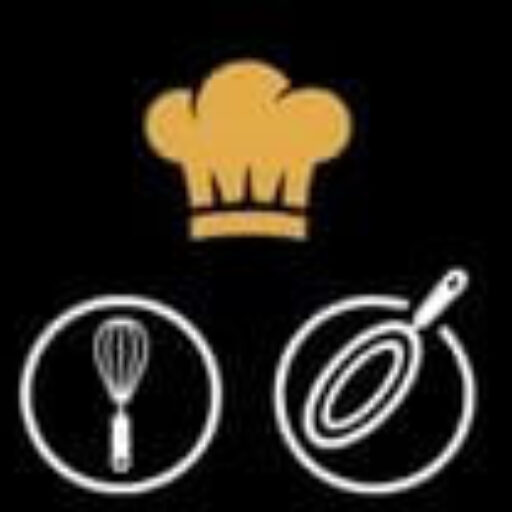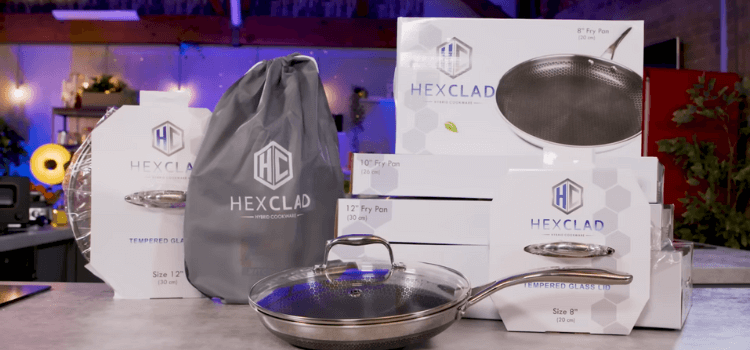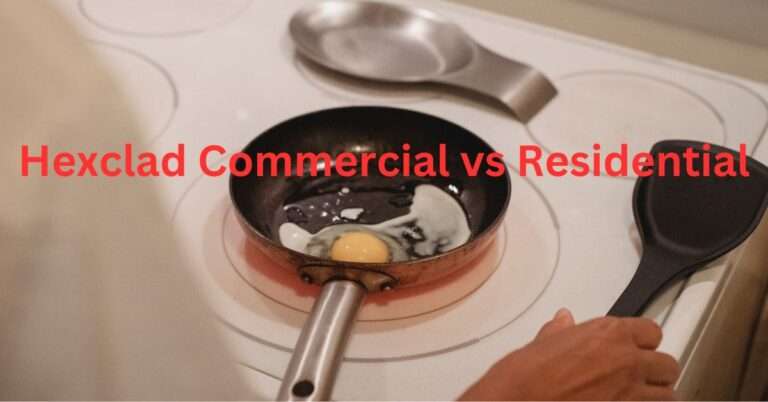HexClad vs Scanpan (2025): Which Cookware Should You Choose?
Last updated on November 19th, 2025
If you’re torn between HexClad and Scanpan, you’re not alone. These two premium cookware brands are often compared for their sleek design, advanced nonstick tech, and chef-level performance.
HexClad stands out with its stainless-steel hybrid surface and celebrity backing (hello, Gordon Ramsay). Scanpan, crafted in Denmark, offers a more traditional nonstick feel with an eco-conscious edge.
Both are pricey—but are they worth it? And which one truly fits your kitchen needs?
In this HexClad vs Scanpan comparison, we’ll break down the pros, cons, and real-world performance of each.
Keep reading to find out which pan sizzles and which one fizzles.
HexClad vs Scanpan – Quick Comparison Table
| Feature | HexClad | Scanpan |
| Country of Origin | USA (designed), made in China | Denmark |
| Material | Hybrid: Stainless steel + Nonstick ceramic | Pressure-cast aluminum + Stratanium+ coating |
| Nonstick Coating | PTFE-based hybrid with laser-etched steel | PTFE-based (Stratanium / Stratanium+) |
| Oven-Safe Temp | Up to 500°F | Up to 500°F (depending on line) |
| Induction Compatible | Yes | Most models (check specific product) |
| Dishwasher Safe | Yes (but hand washing recommended) | Yes (but hand washing recommended) |
| Metal Utensil Safe | Yes | Some models – better with silicone/wood |
| Warranty | Lifetime (limited) | Lifetime (limited) |
| Best For | Searing, hybrid cooking, stainless steel feel | Traditional nonstick lovers, eco-conscious users |
| Price Range | $$$ (Premium) | $$$ (Premium) |
Brand Background: HexClad and Scanpan

HexClad: The Hybrid Game-Changer
HexClad is a relatively new player in the cookware world, but it’s made a big splash—especially after earning praise from celebrity chef Gordon Ramsay. Launched in the U.S., HexClad cookware features a unique hybrid design that combines stainless steel with a nonstick ceramic coating, laser-etched into a hexagonal pattern. This gives you the best of both worlds: the searing power of stainless steel and the easy cleanup of nonstick.
While the design is patented in the U.S., most HexClad products are manufactured in China, which keeps production efficient while maintaining high quality. The brand markets itself as professional-grade cookware that’s also practical for home chefs.
If you want pans that look high-end and can handle steak night just as well as scrambled eggs, HexClad delivers on style and strength.

Scanpan: Danish Craftsmanship with a Green Touch
Scanpan has been making high-performance cookware since 1956 in Denmark, where all of its products are still manufactured today. Known for its strong stance on sustainability, Scanpan uses 100% recycled aluminum in its cookware, making it a favorite among eco-conscious cooks.
Its signature Stratanium+ coating is a next-generation PTFE-based nonstick layer, offering a smoother surface, better food release, and longer wear than older nonstick technologies. While it doesn’t look as flashy as HexClad, it’s built for durability and day-to-day performance.
Scanpan is for those who value long-lasting nonstick performance, eco-friendly production, and European engineering.
HexClad vs. Scanpan: Key Difference
Design & Build Quality
When it comes to cookware, design isn’t just about looks—it’s about how the pan feels, handles, and holds up over time. Let’s take a closer look at how HexClad and Scanpan stack up in this department.
HexClad: Flashy, Tough, and Unique
HexClad stands out right away with its laser-etched hexagon pattern. That hybrid surface blends stainless steel and nonstick—something you don’t see every day. It feels solid in your hand, with a tri-ply construction (stainless + aluminum core + stainless). This gives it great heat distribution and a sturdy feel on the stovetop.
Its stainless steel exterior is sleek and modern but also shows smudges easily. You’ll need to wipe it down often if you want that “Instagram kitchen” look.
Another thing to note: HexClad pans are a bit heavier than your average nonstick. That’s not a dealbreaker—but if you cook often or have wrist pain, it’s something to keep in mind.
💡 Tip: HexClad handles stay cool on the stove, but they can get warm near high heat. Always grab a towel just in case.
Scanpan: Smooth, Sleek, and Surprisingly Sturdy
Scanpan takes a different approach. It’s made with pressure-cast aluminum, which makes the pans both lightweight and super durable. The surface is smooth, with no flashy patterns—just a clean, matte black finish that fits in any kitchen.
Unlike HexClad, it doesn’t use stainless steel on the outside. That means no smudging, less polishing, and easier cleanup. It’s also less prone to warping because of how it’s molded under high pressure.
What makes Scanpan extra special is its Stratanium+ coating, which is fused right into the aluminum. That means the surface won’t peel or chip like older nonstick pans sometimes do.
💡 Pro Tip: Scanpan’s flat bottom makes full contact with glass or induction cooktops—great for even heat!
Verdict: Which Has Better Build?
- Go with HexClad if you like the feel of stainless steel and want something truly different.
- Choose Scanpan if you prefer a lighter, more traditional nonstick pan that’s easy to handle and clean.
Both brands offer great build quality—but they’re built for different types of cooks. It really depends on what matters more to you: bold design or everyday practicality.
Read More: Best Korean Cookware Brands
Cooking Performance & Heat Distribution
How well do these pans actually cook? Let’s dive into real-world results with HexClad and Scanpan—whether you’re making pancakes, sautéing veggies, or searing a steak.
HexClad: Hot, Even, and Sear-Ready
HexClad cooking performance is impressive—especially for high-heat lovers. Thanks to its tri-ply construction, it heats up fast and spreads heat evenly across the base. You’ll get a consistent sear, whether you’re browning chicken thighs or making crispy hash browns.
One unique feature: the stainless-steel ridges allow better browning than most nonstick pans. This makes HexClad ideal for dishes that need some crust—like smash burgers or salmon fillets.
But there’s a trade-off. Foods like eggs or crepes may stick a little more if you don’t use enough oil or preheat properly.
💡 Tip: Always preheat HexClad on medium for a minute or two before adding food. It performs best when hot.
Scanpan: Smooth, Gentle, and Great for Daily Cooking
Scanpan heat distribution is also solid—especially for a nonstick pan. It may not brown like stainless, but it shines in low-to-medium heat cooking. Think stir-fried veggies, omelets, or reheating leftovers.
Because of the Stratanium+ nonstick surface, food glides right off. You can scramble eggs with almost no oil, and cleanup takes seconds. That makes it a go-to for everyday meals and quick weeknight dinners.
However, it’s not ideal for high-heat searing. Cranking the heat too much can wear out the coating faster.
💡 Pro Tip: Keep Scanpan on medium heat for best results—and longer non stick life.
Verdict: Which One Cooks Better?
- Choose HexClad if you want more versatility—especially for searing, sautéing, or hybrid cooking styles.
- Go with Scanpan if you cook mostly eggs, fish, or stir-fries and love the convenience of true nonstick.
Both deliver solid heat distribution, but HexClad is better for high-heat performance, while Scanpan excels in everyday, low-oil cooking.
Read More: Best David Burke Cookware at TJ Maxx
Nonstick Coating & Durability
Let’s talk about what really matters after a few months of cooking: how long the nonstick lasts and how well it holds up.
HexClad: The Hybrid Nonstick That Acts Like Stainless
HexClad doesn’t use your typical nonstick coating. Instead, it combines stainless steel peaks with nonstick valleys made from a PTFE-based ceramic blend. It’s a patented design that gives you the best of both worlds—nonstick convenience and stainless-steel durability.
In real-world use, the HexClad nonstick durability is solid. You can use metal utensils without worrying too much, and the coating doesn’t peel or scratch easily. But there’s a catch: food can still stick a little—especially eggs or pancakes if you skip the preheat or don’t use oil.
💡 Tip: Think of HexClad as a stainless pan with nonstick assist—not a fully slick surface. A quick wipe of oil goes a long way.
It’s also dishwasher-safe, though hand washing is better for long-term life.
Scanpan: Nonstick That Lasts (When Used Right)
Scanpan uses a next-gen nonstick coating called Stratanium+. It’s PTFE-based but PFOA-free and fused directly to the aluminum body. That means no peeling, no bubbling, and a smooth surface that lasts—if you treat it right.
You’ll get excellent nonstick performance for 2–5 years, sometimes longer. You can use metal utensils, but plastic or silicone is better for preserving the coating. And while it can handle high heat, staying in the low-to-medium range makes it last longer.
💡 Pro Tip: Avoid aerosol sprays like PAM—they degrade Scanpan’s nonstick faster. Use real oil or butter instead.
Unlike many nonstick pans, Scanpan can also go in the dishwasher, but again—hand washing is the gentler choice.
Verdict: Which One Lasts Longer?
- Go with HexClad if you want a scratch-resistant surface with hybrid performance. Just be ready for a little learning curve.
- Choose Scanpan if you want a smooth, easy-to-use nonstick pan and you cook often at moderate temps.
Both offer excellent durability—but they wear differently. HexClad takes more heat and metal tools, while Scanpan rewards gentle use with buttery-smooth results for years.
Safety & Materials
When choosing cookware, safety matters just as much as performance. Let’s look at what HexClad and Scanpan use and how safe they are for your kitchen.
HexClad Safety: Hybrid Design with Food-Safe Materials
HexClad pans combine stainless steel and a PTFE-based nonstick coating. The PTFE (think: traditional nonstick) is FDA-approved and safe when used properly—meaning no overheating or scratching.
HexClad is also PFOA-free, which is a big plus since PFOA is linked to health concerns in older cookware. The stainless steel parts add durability and reduce direct contact with the nonstick layer, which some cooks appreciate for safety.
💡 Tip: Never heat HexClad empty on high for too long. That can damage the coating and release fumes. Use medium heat for best safety.
Scanpan Materials: Eco-Friendly and Non-Toxic
Scanpan shines with its commitment to green manufacturing. Made in Denmark, it uses 100% recycled aluminum as the base—a big win for the environment.
Its Stratanium+ nonstick coating is PFOA-free and made without harmful chemicals. Scanpan is tested to withstand heat safely up to 500°F, which covers most cooking needs.
Plus, Scanpan’s solid build means no risk of flaking or peeling harmful particles into your food.
💡 Pro Tip: Scanpan’s aluminum core heats quickly but stays lightweight, making it easier on your wrists and safer to handle.
Verdict: Which Is Safer?
Both HexClad and Scanpan use safe, modern materials designed to keep your food healthy.
- Choose HexClad if you want a hybrid pan that balances stainless steel strength with safe nonstick surfaces.
- Go with Scanpan if you prefer eco-friendly, non-toxic cookware with a strong safety record.
Either way, following the manufacturer’s care tips will keep your pans safe and healthy for years.
Price & Value
Let’s get real—price matters. Both HexClad and Scanpan come with premium price tags, but is the cost worth it? Let’s break it down.
HexClad: Investment for Innovation
HexClad pans are usually priced on the higher end. You’re paying for the unique hybrid design, tri-ply build, and patented technology. A single 10-inch skillet can cost around $200 or more.
Is it worth it? If you want a pan that does a little bit of everything—nonstick convenience plus the searing power of stainless steel—HexClad delivers. Many users say it lasts long and performs well, making it a smart long-term investment.
💡 Tip: Buying a set rather than individual pieces can save you money if you want multiple sizes.
Scanpan: Classic Quality at a Steady Price
Scanpan’s pricing is slightly lower but still in the premium category. A 10-inch Scanpan skillet typically runs around $150 to $180.
You’re paying for durable nonstick coating, eco-friendly materials, and Danish craftsmanship. If you mostly cook eggs, fish, or quick stir-fries, Scanpan gives you excellent value for everyday use.
💡 Pro Tip: Watch for sales or bundles—Scanpan often has deals that make it more affordable.
Verdict: Which Offers Better Value?
- HexClad is great if you want innovation and versatility and don’t mind spending more upfront.
- Scanpan offers solid quality and excellent nonstick performance at a slightly lower price.
Both give good value, but the best choice depends on your cooking style and budget.
Read More: Cast Iron vs Ceramic Cookware: Which One is Better?
Best For… (User Intent)
| Scenario | Best Option |
| Everyday nonstick cooking | Scanpan |
| Professional-style searing | HexClad |
| PTFE-free nonstick | Scanpan CTX |
| Aesthetics / Kitchen flex | HexClad |
| Budget-conscious buyers | Scanpan |
Pros and Cons of HexClad vs Scanpan
Let’s wrap up with a quick look at the strengths and weaknesses of HexClad and Scanpan to help you decide which fits your kitchen best.
HexClad
Pros
- Hybrid design combines stainless steel durability with nonstick convenience
- Great for high-heat cooking and searing
- Can use metal utensils without damaging the surface
- Dishwasher safe (though hand washing is better)
- Long-lasting with proper care
Cons
- Higher price point compared to traditional nonstick
- Food can stick if not preheated or oiled properly
- Slight learning curve for best results
Scanpan
Pros
- Excellent nonstick coating with smooth release
- Eco-friendly materials and PFOA-free coating
- Lightweight and easy to handle
- Great for low-to-medium heat everyday cooking
- Dishwasher safe, easy cleanup
Cons
- Not ideal for very high-heat searing
- Nonstick wears faster if overheated or abused
- Slightly less versatile than HexClad
Both pans offer solid quality and unique benefits. Your choice depends on what you cook most and how you use your pans.
Should You Buy HexClad or Scanpan?
It really depends on how you cook and what you expect from your pans.
Choose HexClad if you want a bit of everything—stainless steel strength, nonstick ease, and the ability to use metal utensils without worry. It’s perfect for home chefs who love searing meats, finishing dishes in the oven, or experimenting with high-heat cooking. Plus, it looks sleek on your stovetop.
Real tip: If you often cook steaks, salmon, or stir-fry on high heat—HexClad delivers serious performance. It also works beautifully on induction cooktops and handles everyday wear like a champ.
Go with Scanpan if you’re all about convenience. It’s lighter, heats up fast, and cleans up in seconds. Great for busy home cooks making eggs, pancakes, or quick weeknight meals. It’s also eco-friendly and made with recycled aluminum—bonus points for sustainability!
Real tip: If you prefer easy, low-oil cooking and don’t want to fuss over pan care, Scanpan is your kitchen buddy.
There’s no “one-size-fits-all” answer in the HexClad vs Scanpan debate. But when you match the cookware to your cooking style, you’ll enjoy better meals—and less stress in the kitchen.
Need help picking the right set for your needs? Let me know—I can guide you based on your cooking habits!
Conclusion
Both HexClad and Scanpan bring something special to your kitchen. It really boils down to your cooking style and what you value most.
If you want a durable, versatile pan that can handle high heat, metal utensils, and a mix of cooking tasks, HexClad is a fantastic choice. Its hybrid design gives you the power of stainless steel with nonstick ease—perfect for those who like to experiment and want long-lasting cookware.
On the other hand, if you’re after easy, reliable nonstick performance for everyday meals like eggs, pancakes, and stir-fries, Scanpan delivers smooth cooking and easy cleanup. Plus, it’s eco-friendly and lightweight, making it a solid pick for busy cooks who want dependable quality without fuss.
Frequently Asked Questions
1. Is HexClad worth the price?
Yes! HexClad’s unique hybrid design offers a great mix of stainless steel durability and nonstick convenience. While it’s priced higher than many pans, many users find it worth the investment for its versatility and long-lasting performance.
2. Does HexClad or Scanpan last longer?
Both are durable, but HexClad tends to last longer if cared for properly. Its stainless steel and hybrid build handle wear and tear better. Scanpan’s nonstick coating is excellent but can wear faster with heavy use or high heat.
3. Which is better for induction cooktops?
HexClad is great for induction cooking thanks to its tri-ply stainless steel base designed for even heat distribution. Scanpan also works on induction, but HexClad has the edge for performance on these cooktops.
4. Are these pans dishwashers safe?
Yes, both HexClad and Scanpan are technically dishwasher safe. However, hand washing is recommended to preserve the nonstick coating and extend the life of your pans.
5. Can I use metal utensils with Scanpan?
It’s best to avoid metal utensils with Scanpan to prevent scratching the nonstick surface. Using silicone, wood, or plastic utensils will help keep your Scanpan in top shape longer.







